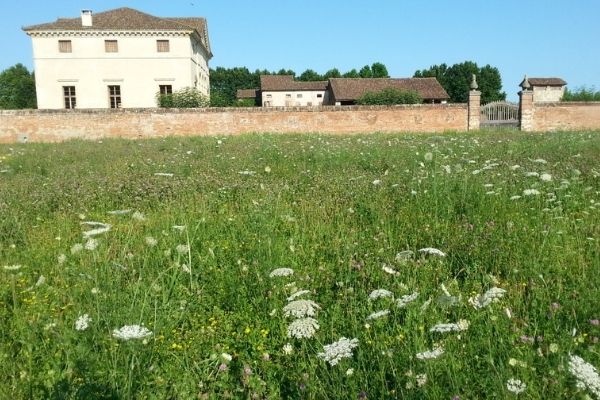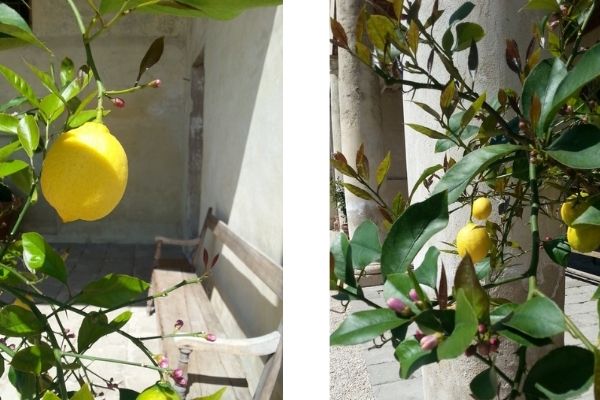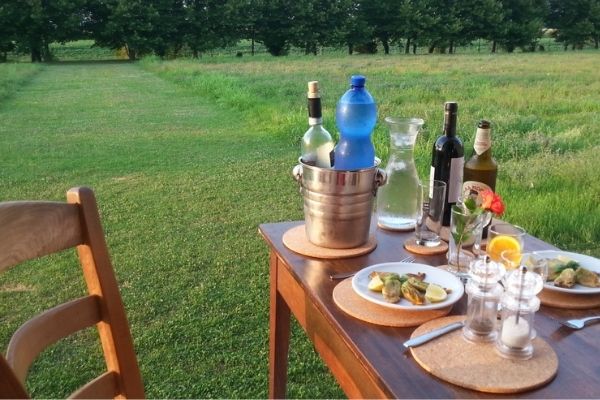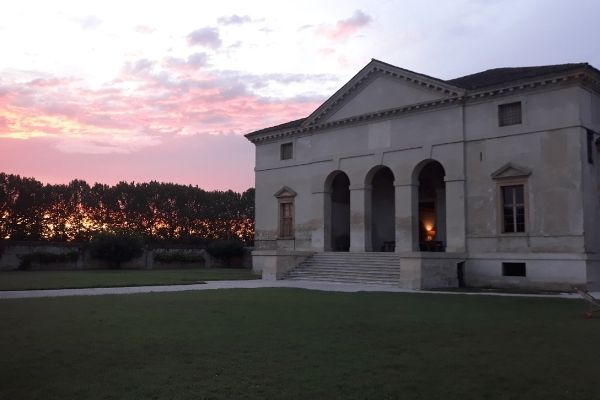I – we – have stayed at Villa Saraceno several times over the years, sometimes as a family, sometimes with friends or as guests of friends. It is a deeply favourite place. We have stayed for three or four nights but a few years ago made it our main summer holiday. Ten wonderful nights stretched ahead.
That Landmark has one of Palladio’s villas is in itself a remarkable thing. If Landmark is to have one, when you stay there it’s hard to escape the thought that Villa Saraceno is the only villa by Palladio that could possibly have become a Landmark. In none of the others can you live for yourself, explore from attic to cellar. One of Palladio’s simplest villas, its spaces are still grand, its proportions perfect, awe-inspiring.

And yet this villa is entirely habitable. Its gentle symbiosis alongside the pre-existing buildings (earlier house, converted dovecote, barns, walls…) is endearing and reassuring. While the wonder of moving through its spaces never leaves me, we feel comfortable here. It becomes (modestly) home, rising silently, significantly out of the Veneto plain, a setting of agricultural simplicity ringed by the green conical hills so loved by Petrarch.
Once, today’s quiet corte or walled enclosure to the front would have hummed with farmyard bustle. Today, only the cicadas sing and doves coo, with the occasional hoot from the little scops owl that’s taken up residence in the barn and likes to sit on its ridge tiles waiting for the sun to set. I think how these familiar sounds unite us across the centuries with our predecessors, as surely a shared experience as the full moon seen from the candlelit loggia or the sound of someone, unseen, whistling an air in another room.
A chief pleasure of any stay is the Italian abundance of produce, whether picked up from a roadside stall, the great daily market at Padua or even the hypermarket up the road: fully ripe tomatoes warm from the sun, green beans, sage and marjoram in great handfuls, peppers and perfectly spherical, pale violet aubergines. In August, there are greengages so ripe they’re almost buttery, magenta and cream borlotti beans, fragrant white nectarines, courgette flowers, tender young arugula, creamy burrata. At the Villa, a hazel tree drops nuts daily, and figs and green and red grapes hang ripe against the corte walls. The gastronomic possibilities are endless. The cookbook of the stay becomes Ruth Rogers’ and Rose Gray’s brilliant River Café Easy, perfect holiday cooking as successive cooking shifts revel in the profusion of Italian produce ingredients.
A secret pleasure each morning is to be up early and first, and to open the pairs of great double doors that flank the sala, that amazing central space. The north-south axis means opening the central doors of the raised villa catches the east-west breezes from the Dolomites. Even in August the sala is always cool. Each early morning, I waver over which doors to open first. Do I choose those to the south, that open onto the corte, its perspective leading to the flaming urns on the gateposts, flanked on one side by two graceful trees and satisfyingly continued beyond by a track along a surely ancient field boundary, and on the other by the warm brick arches of the mighty barn and vines shading the custodians’ house to one side? Or the doors to the north, opening onto the brolo or meadow, a more secret side where a sense of agricultural purpose can still be caught. The farmer has yet to gather in several giant rolls of hay; custodian Fabio has brilliantly mown a broad sward through the hay meadow from the doors to surrounding irrigation canal. While we stay, the meadow has sprung back into life a second time. There are butterflies galore – peacocks, red admirals, tortoiseshells, and more blues and skippers than I can identify. Day by day, the meadow becomes flower strewn all over again as pink clover, buttercups, white yarrow, nodding grasses lift their heads above the lush new growth.

The wildlife in August is different from our other, springtime visits. The nightingale that sings so heart-stoppingly in May is not here, flown north to cooler climes. In spring, the night air is alive with a chorus of frogs punctuated by the bittern’s boom; now only cicadas chirrup in the dusk. The bitterns are nesting along the canal. They seem silent now, but we think we hear an oriole and see several herons. A peregrine falcon hovers – I see it dive onto prey one early brolo morn. We later see from the Logbook entry by a proper ornithologist that a pair of peregrines is nesting in one of the trees. My eye rests on the Renaissance hunting scene that hangs in the kitchen, and I wonder if the Saracenos ever rode forth to hunt in the morning dew, falcons on their wrists.
The tide of our friends crests at the weekend. Those of us not on cooking duty that night gather on the warm steps of the loggia as the sun slips ‘a settana’ towards the line of trees to the west. Unusually, the doors to the sala are closed: we’re banned until a moment of reveal. We sip Prosecco, lounging on the steps. There’s a hiatus (‘the oil won’t boil’) but caught in the moment we don’t care. The antipasti arrive in due course: fried courgette flowers stuffed with ricotta and a basil leaf (River Café again). Someone’s brought a couple of bottles of Veuve Cliquot duty free from Stansted, and we open those to accompany them. Heaven.

When the sala doors are finally flung open, the moment does not disappoint, long table set for twelve with candles in tumblers over African marigolds and huge sunflowers in empty Jeroboams found in the barn – Landmarks have a way of conjuring such improvisation. The golden frescoes glow above the candlelight as conversation beats to and from beneath them. Pork in fennel seeds is followed by baked nectarines. A ping pong foursome breaks away, soon joined by the rest for a round-the-table tournament, with great hilarity and considerable cheating. But the golden glow of the sala draws us back to the sunflowers and the frescoes, for speed drawing – ‘capture my pose’ in three minutes, two minutes, six lines, thirty seconds. Few of the results are remotely recognisable. Then the hunting scene is brought in from the kitchen – a challenge to each to tell its story? Warm goodnights, around 3am. It’s yet another memorable Landmark evening to add to our store, uniquely ours, yet replicated so often by so many others in other Landmarks.
On our last morning, I open the doors onto the brolo (I have decided finally this is my favourite order) and the giant hare we have glimpsed a couple of times springs up startled and leaps away, hind legs and large ears bobbing above the dew laden grass towards the risen sun. We’ve had two last lovely days just the pair of us in the villa, winding down but not rattling around. These are spaces that settle around you, comfortably, familiarly, helping you feel a better self but without ever over-aweing. Above all these are habitable rooms, created by someone who elevated, but understood, the human scale.

I love Villa Saraceno fiercely and possessively: I know this is how most Landmarkers feel about most Landmarks. This is absolutely as it should be. We can all live the illusion that a Landmark building is ours – and while we are there, this is not an illusion but true. There is a Logbook entry at the villa that reads simply ‘One experience can change a life.’ I reflect that this is also true. Saraceno changes mine, each time. Leaving is made bearable only by resolving yet again that we will return, and that I will again open the double doors onto the flower strewn brolo in the early morn, and watch the hare bound away.
Our Italian buildings